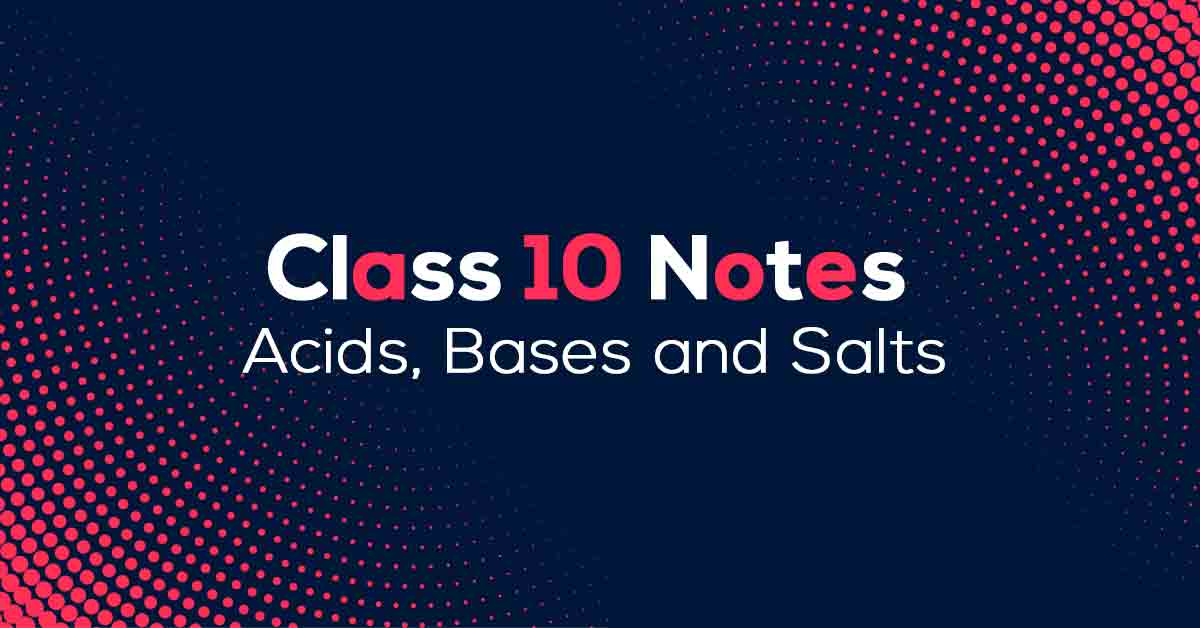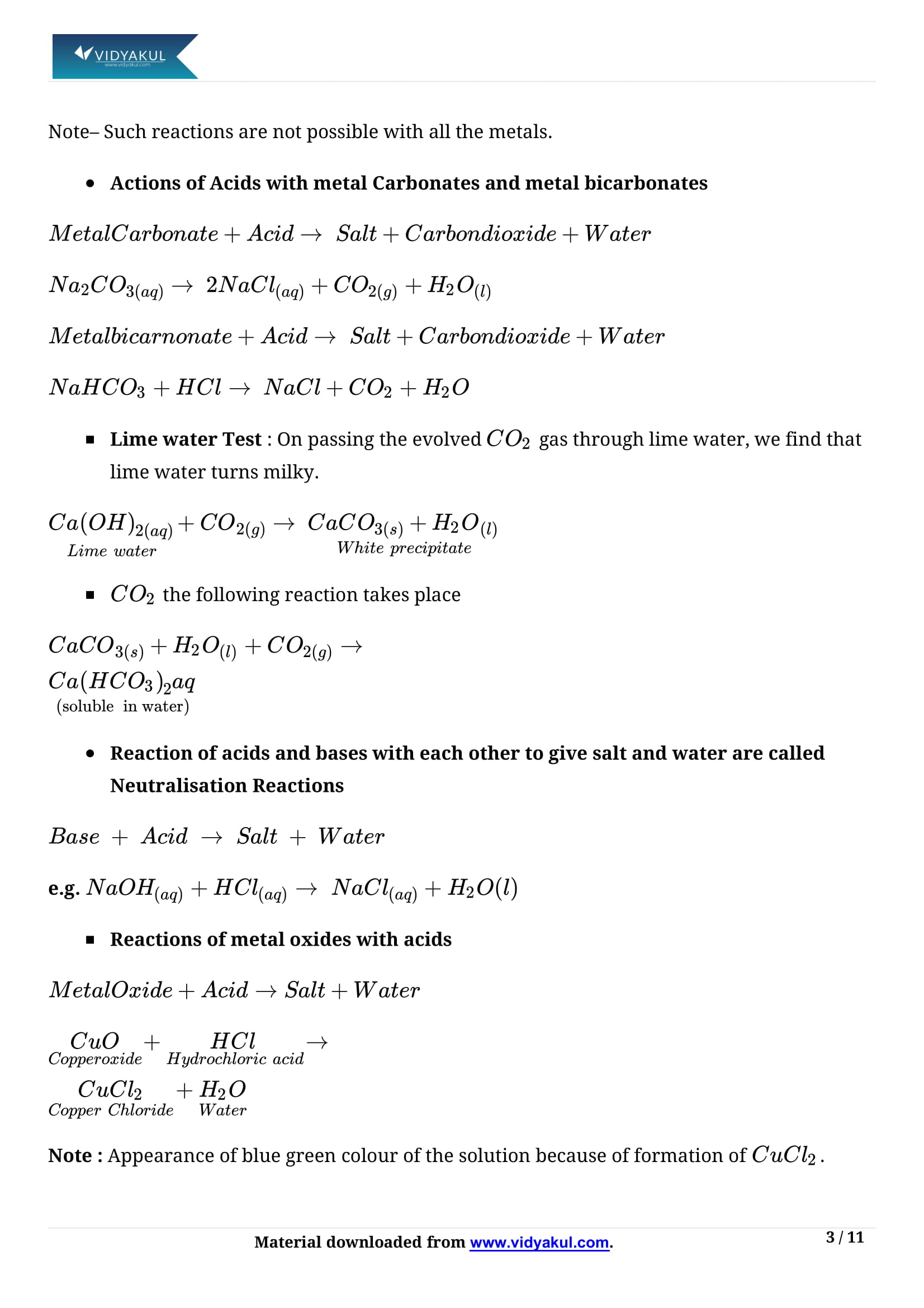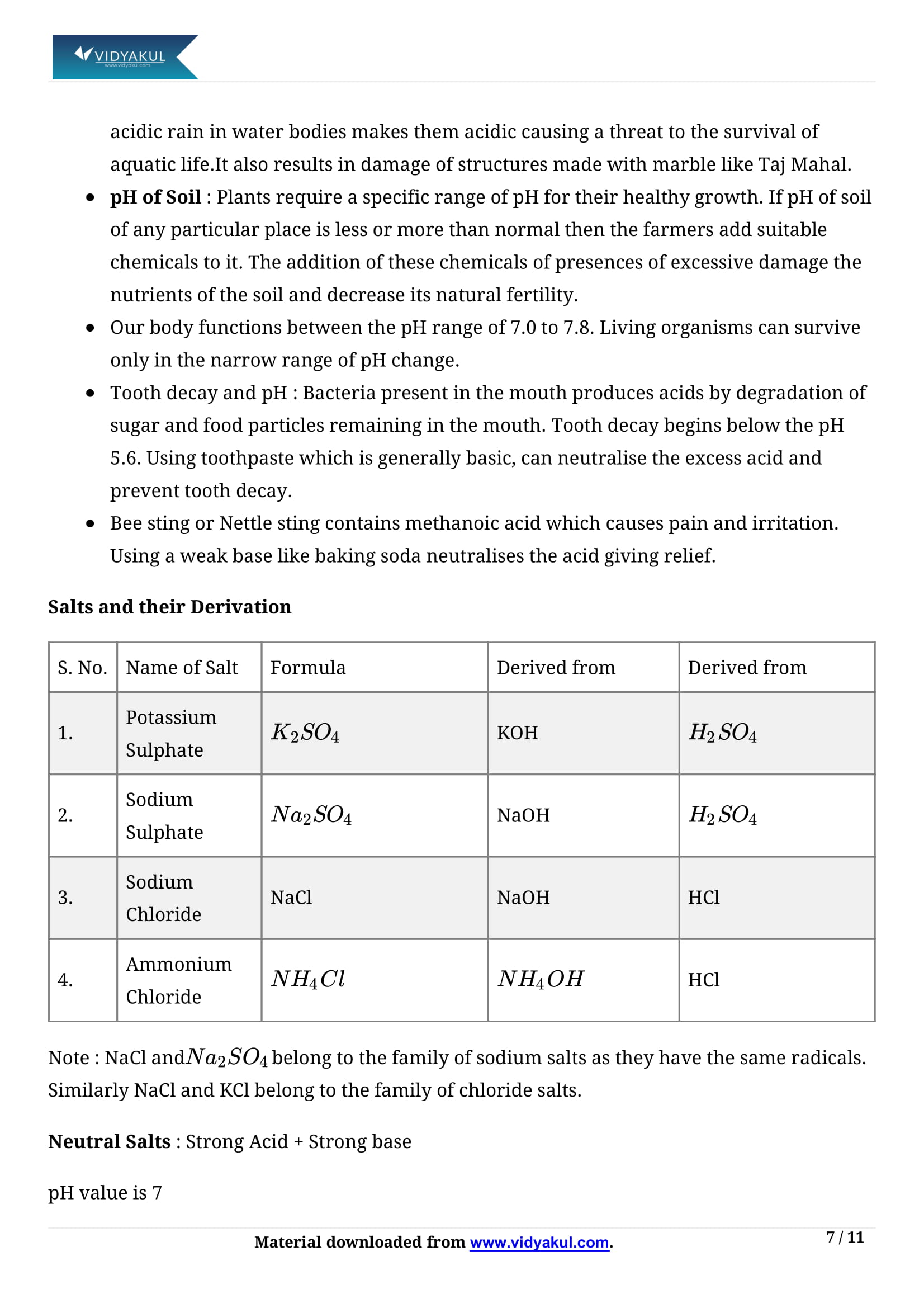Acids, Bases and Salts Class 10 Notes

Chapter 2 Acids, Bases and Salts
It is very important that students thoroughly study the NCERT textbooks and notes in order to maximize their scores. Science is a subject in which 10th graders score highly on board exams. Chapter 2 (Acids, Bases and Salts) of CBSE Class 10 Science is one of the important chapters of CBSE Class 10 Science. Students should carefully analyze the NCERT text questions.
CBSE Class 10 Science Chapter 2 covers natural indicators, acid-base indicators, chemical properties of acids and bases, reactions of acids with metal bicarbonates, and reactions of metal carbonates with acids. Vidyakul provides a set of over 450 exercises covering all the subtopics covered in Chapter 2. Students should focus on practicing text-based questions in Vidyakul to score well on the exam. Scroll down to learn about NCERT Class 10 Science notes for Chapter 2.
CBSE CLASS 10th SCIENCE CH-2
Points to Remember
Students can note down the important points to remember from NCERT Class 10 Science chapter 2 as mentioned below:
Indicator:
(i) An indicator is a chemical substance which is used to indicate acidic or basic or neutral nature of an aqueous solution of a substance
(ii) Indicators may be natural (litmus, turmeric and red cabbage,) or synthetic (phenolphthalein and methyl orange). Some indicators (onion paste, vanilla essence and clove oil) distinguish acids and bases with their odour. Such indicators are called olfactory indicators.
Acids:
(i) Acids are the substances that dissociate in water to give hydrogen ions (H+) or hydronium ions (H3O+)
(ii) Acids may be classified as:
(a) Organic and inorganic acids (On the basis of source from which they are obtained).
(b) Strong and weak acids (On the basis of their extent of dissociation in aqueous solution).
(c) Concentrated and dilute acids (On the basis of their concentration in water).
Acids taste sour and turn blue litmus to red. They are corrosive in nature. Their aqueous solutions conduct electricity.
Acids react with metals to form salt and hydrogen gas.
Acids react with metal carbonates and metal hydrogen carbonates to form salt, carbon dioxide and water.
Acids react with basic metallic oxides to form salt and water.
Bases:
(i) Bases are the substances that dissociate in water to give hydroxide (OH–) ions. A base which is soluble in water is known as alkali.
(ii) Bases are classified as strong and weak bases on the basis whether they dissociate completely in water or not.
(iii) Bases are bitter to taste and turn red litmus to blue. They are soapy in touch and corrosive in nature. They conduct electricity in aqueous medium.
(iv)Bases react with some active metals like zinc on heating to form salt and hydrogen gas.
(v)Non-metallic oxides being acidic in nature react with bases to form salt and water.
Topics and Sub-topics
Acids, bases and salts are one of the most exciting topics in 10th grade. Students develop a deeper understanding of the chemical reactions of acids and metals, their chemical properties, and more. It will be very interesting for students to learn and learn more about different reactions. It is recommended that students practice as many questions as possible so that they can answer all types of questions asked on the exam. Vidyakul provides free answers to all questions in Grade 10 Science Chapter 2. All questions and concepts are based on the latest program.
Students can view the list of topics provided in CBSE Class 10 Science chapter 2 as mentioned below:
Few Important Questions
When dissolved in water, Arrhenius base is a compound that ……….?
An Arrhenius base is a compound that increases the concentration of OH– ions that are present when added to water.
A solution X has a pH value of 2 and another solution Y has a pH value of 1. What can be inferred regarding the difference in hydrogen ion concentration between them?
pH is a measure of hydrogen ion concentration in a solution. Higher the hydrogen ion concentration, lower is the pH. Acids which give rise to more hydrogen ions are more acidic than the acids which give less hydrogen ions. Thus, lower the pH, higher is the acidic nature of the solution. Thus, Y has more hydrogen ion concentration than X.
Dilute hydrochloric acid (HCl) reacts with metals to evolve __ gas along with the formation of corresponding metal salt.
Acids react with metals to produce the respective metal salt along with hydrogen gas. Therefore, when hydrochloric acid (HCl) reacts with metals it evolve hydrogen gas along with the formation of corresponding metal salt.
Indicator:
(i) An indicator is a chemical substance which is used to indicate acidic or basic or neutral nature of an aqueous solution of a substance
(ii) Indicators may be natural (litmus, turmeric and red cabbage,) or synthetic (phenolphthalein and methyl orange). Some indicators (onion paste, vanilla essence and clove oil) distinguish acids and bases with their odour. Such indicators are called olfactory indicators.
Acids:
(i) Acids are the substances that dissociate in water to give hydrogen ions (H+) or hydronium ions (H3O+)
(ii) Acids may be classified as:
(a) Organic and inorganic acids (On the basis of source from which they are obtained).
(b) Strong and weak acids (On the basis of their extent of dissociation in aqueous solution).
(c) Concentrated and dilute acids (On the basis of their concentration in water).
Acids taste sour and turn blue litmus to red. They are corrosive in nature. Their aqueous solutions conduct electricity.
Acids react with metals to form salt and hydrogen gas.
Acids react with metal carbonates and metal hydrogen carbonates to form salt, carbon dioxide and water.
Acids react with basic metallic oxides to form salt and water.
Bases:
(i) Bases are the substances that dissociate in water to give hydroxide (OH–) ions. A base which is soluble in water is known as alkali.
(ii) Bases are classified as strong and weak bases on the basis whether they dissociate completely in water or not.
(iii) Bases are bitter to taste and turn red litmus to blue. They are soapy in touch and corrosive in nature. They conduct electricity in aqueous medium.
(iv)Bases react with some active metals like zinc on heating to form salt and hydrogen gas.
(v)Non-metallic oxides being acidic in nature react with bases to form salt and water.
When dissolved in water, Arrhenius base is a compound that ……….?
A solution X has a pH value of 2 and another solution Y has a pH value of 1. What can be inferred regarding the difference in hydrogen ion concentration between them?
Know more about this in Acids, Bases and Salts Class 10 Notes pdf.
Download Latest Class 10 Sample Papers 2019 for Board Exams
- CBSE Class 10 Sample Papers 2019 PDF
- CBSE Class 10 Maths Sample Papers 2019 PDF
- CBSE Class 10 Science Sample Papers 2019 PDF
- CBSE Class 10 English Sample Papers 2019 PDF
- CBSE Class 10 Hindi Sample Paper 2019 PDF
- CBSE Class 10 Social Studies Sample Papers 2019 PDF
Download this solution for FREE Download this PDF
Download Vidyakul App for more Important notes, PDF's and Free video lectures.














